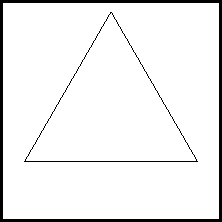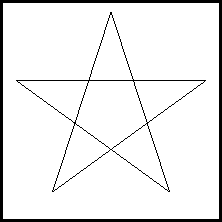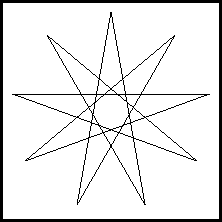- Assigned:
- August 27, 1999
- Due Date:
- September 10, 1999, 10:00am
This is a simple MP to get you acquainted with OpenGL, WindowsNT, and the
machines in the Multimedia Lab (1265 DCL). It will give you a chance to
learn the Visual C++ development environment if you are not already
familiar with it, practice your C skills, and read the OpenGL manual
available on the class web page.
You will be using the built-in drawing commands of OpenGL to draw
a very simple graphic. Look at the code samples in the OpenGL tutorial
to help you generate a program skeleton.
Upon completion of this MP, you should be able to do the following
things:
- Login to the NTs and know how to use the windowing environment;
- Use Visual C++ to create a C program; and
- Know the basics of OpenGL and be able to apply them to a program.
Read Chapters 1 and 2 in the required text for this class - ``Computer
Graphics, C Version, 2nd Edition'' by Hearn & Baker. Chapter 1 contains
background material on computer graphics and has lots of pictures. Chapter
2 gives a good introduction to computer graphics systems. Read them
now while you have the time. Also, an OpenGL supplement to this
textbook is available. You can view it online at
http://www-courses.cs.uiuc.edu/~cs318/OpenGL.html.
If you registered for the class before August 23, 1999, then an account
has automatically been set up for you on the multimedia machines (the
WindowsNT boxes in 1265 DCL). If you registered for the class after this
date, you may not yet have an account. The TA may need to set up an account
for you. Send e-mail to cs318ta1@cs.uiuc.edu to make such a
request.
Once your account is set up, you need to get the password for your
account. Go any lab sitter (in 1235,1245, or 1275 DCL) and show your
Student ID. You will receive a password for your CS318 account. Next, go
to one of the WindowsNT machines and login. You should change your password
when you first log in so that it is easier for you to remember.
Note: When you get your WindowsNT account, you also get an account on the
Sun Sparcs. Initially the password you get from the labsitter will work on
both accounts. However, the NTs and the Suns have independent password
servers, so if you change your password on one platform, it will not change
on the other. You have to do this manually for each of the two platforms.
There is extensive information available on the web page for this
class. You should look at it to get an idea of the type and scope of
information available. This will save you time later when you have
questions.
The class web page is at http://www-courses.cs.uiuc.edu/~cs318/.
There, you will find links to information about the class,
the textbooks you will need, how to compile your programs, etc. As the
semester progresses, you may wish to look at these pages for more detailed
information.
We will be lecturing on some basic OpenGL commands in class, but
there is no substitute for experience. There is no required textbook for
OpenGL, but you are still expected to learn OpenGL primarily on your
own during this course. There are several ways to do this.
- Buy the OpenGL books. The titles and authors are available
on the class homepage. Go to the Textbooks
link. (The ``OpenGL Programming Guide, 2nd Edition'', aka ``The Red
Book'', is available in the bookstore. It is an excellent
reference for learning OpenGL. The ``OpenGL Reference'', aka
``The Blue Book'', is pretty much optional.)
- Go to the SGI OpenGL web sites at
http://www.sgi.com/software/opengl/ AND
http://www.opengl.org/
and read the (very extensive) documentation there.
- Read the various man pages available on the web:
OpenGL has a very large feature set and cannot be learned in one sitting.
You should budget your time accordingly. Plan to spend about 2-4 hours
reading the introductory material on OpenGL before you begin programming.
Also, remember that there are many students in CS318 and only 30
WindowsNT machines. Realize that the machines may be in use full-time as
the due date approaches.
You are to write a program which generates a ``spirograph''. (Some of you
may remember this toy from your childhood.) Basically, a spirograph creates
circular shapes by connecting many line segments in different patterns.
Your program will take two command line arguments: the first specifies
the number of line segments to be used in drawing the figure, and the
second specifies the ``step size'', or how many vertices to skip when
connecting the vertices. Read on for a better explanation.
Name your C source code file mp0.c, and
your program will be called mp0.exe when you compile it. The
following images would be created with the command lines below them.
You need to check to make sure that the user typed in valid input on the
command line. There must be two command line arguments. The first
argument is the number of vertices. This is an odd integer between
3 and 99 (inclusive). The second argument is the ``step size''. This is
an integer greater than 0 and less than the number of vertices.
You can use the C function atoi to convert the command
line arguments to integers. While this is not perfect (eg. an input
of ``34hello'' would be converted to 34 by
atoi), it is suitable for our purposes.
If the user did not enter valid command line argments, print out
an error message indicating the correct usage, and exit.
It is important that you test your programs for many different input
values since you could lose points if your program bombs on some input.
For example, test if it works with no command line options, negative
values, ``strange'' values such as text, etc.
Once you have scanned the command line for valid user input, you need
to draw the spirograph. The figure generated should have a radius of 1.0
and be centered about the origin (0,0). Line segments should all be of
equal length (ie. the vertices of the spirograph should be equidistant
from each other along the perimeter of the unit circle).
You will probably want to use the commands cos and sin
to convert polar coordinates to rectangular coordinates. Be sure to
include the math.h header file in your source code. Also note
that these functions take angles measured in radians, not degrees.
The first point on the spirograph can be anywhere you choose. In the demo,
the first point is placed at position (0,1) on the coordinate axes.
Subsequent points on the unit circle must be generated at runtime based on
the number of line segments entered by the user.
The ``step size'' is used to indicate which vertices are joined by line
segments. A step size of 1 would mean that you connect consecutive
vertices around the unit circle, forming a basic polygon with the number of
sides equal to the number of vertices. A step size of 2 would mean that
you ``skip'' a vertex when going around the circle.
For example, let's say the user had entered values for 5 vertices and a
step size of 2. Let's label these vertices as 1, 2, 3, 4, and 5 going
around the unit circle. Since the step size is 2, we would connect the
vertices in the following order: 1, 3, 5, 2, 4. This results in a standard
``5-point star'' as shown in the second example above. A step size of 3
would result in the vertices connected in the following order: 1, 4, 2, 5,
3. Note that this ALSO produces a star, but in a slightly different
order. Try running the demo to get a better idea of how ``step
size'' is related to ``number of vertices''.
For detailed information on compiling your program on WindowsNT, see the
class web page at:
http://www-courses.cs.uiuc.edu/~cs318/compile.html. The
following discussion assumes that you are using a DOS shell to compile your
program. This is the preferred method, and is also the method that will be
used by the graders. Thus, you need to make sure that your program
compiles and runs using this method.
First, you need to set up the cs318 class directory so that it corresponds
to the G: drive on your NT box. Instructions for doing this can be found
at http://www-courses.cs.uiuc.edu/~cs318/winnt.html.
Next, open a DOS shell by double-clicking on the DOSShell shortcut
in the G:\ directory. This is a special shell for this class that
sets up path information for using the Visual C++ compiler from the command
line. From within this DOS shell, navigate to the location of your mp0.c
file. (Your program must be named mp0.c and NOT
mp0.cpp.)
A special batch file has been set up for you.
To compile your code, type the following at a command prompt:
G:\makewin mp0
This assumes that you have mapped the cs318 class directory to the G:
drive. If successful, you will get a file named mp0.exe in the
current directory. You can compile other MPs in a similar manner by
changing the MP number.
This section lists restrictions that are placed on your program. Please
read this section carefully, or you may lose points by implementing
something incorrectly.
- You may ONLY use C functions and libraries. This will be true of
all MPs in this class. Thus, you cannot use C++ features such as
classes, inheritance, templates, cout, etc.
- You may not use sleep in your program. Instead,
you should use glutMainLoop.
- You may not use the OpenGL rotate routines. Instead,
you should calculate the vertices for the spirograph directly (ie.
using cos and sin).
- You should use only lines to draw your spirograph. You may use
either GL_LINE_LOOP or GL_LINE_STRIP as you
see fit.
- You must put all code in one source file. Name this file
mp0.c. While this may go against what you have learned in
other classes, it is easiest to grade one source code file rather
than searching through many header files for code.
- You must verify that your program compiles and runs
correctly using the makewin batch file on WindowsNT.
If you happen to write your code using a different machine or use
a different compilation method, it is your responsibility
to ensure that your program executes correctly using the method in
the Compiling Your Program section above.
- You need to set up the viewing area of OpenGL to be able to see your
output. This is a fairly complex area which we will be covering this
semester. To facilitate your programming, here is some sample code
you can use to set the camera position.
void SetCameraPosition(void)
{
/* Set the viewing transformation */
glMatrixMode(GL_PROJECTION);
glLoadIdentity();
gluOrtho2D(-1.05,1.05,-1.05,1.05);
glMatrixMode(GL_MODELVIEW);
}
Call SetCameraPosition after you have initialized the main
window, just before you draw your spirograph, and it will appear
centered in your main window.
- To get an idea of what a typical OpenGL program looks like, go
to the Sample Code directory in the class home directory
(http://www-courses.cs.uiuc.edu/~cs318/sample-code/) and
look at some of the programs.
All of the sample programs in this directory use GLUT. You can find
more information about GLUT in the ``OpenGL Programming Guide,
Version 1.1'' (available from the bookstore), and at the online
GLUT man pages at
http://reality.sgi.com/opengl/spec3/spec3.html.
For this and future MPs, we will be using the electronic
handin program. Once you have completed your program,
logon or telnet to one of the Sun Sparc machines (``handin'' does
not work on the WindowsNT machines) and hand in your source code
by typing ``handin cs318 mp0 mp0.c''.
(For more information on handing in your code, consult the class web page at
http://www-courses.cs.uiuc.edu/~cs318/handin.html.)
This will send your program to the class directory for grading.
Do not submit your executable program. Also, put all your
source code in one file. You must hand in your source code file before
10:00am of the due date, as handin will not accept late
assignments. Make sure your name, login, MP#, and date appear at the top
of your code listing. See the class web page for a sample file header.
If your program does not run as required, you will be given at most
50% of the total points for the MP. You are responsible
for making sure your program compiles on the WindowsNT machines using
the makewin batch file.
Late assignments will not be accepted. If you are having problems
beyond your control, you must let a TA know at least 24 hours
before the due date to arrange for a possible extension. There will
be no exceptions!





